Abstract
1. The effects of pirenzepine and gallamine on the membrane and contractile properties of smooth muscle cells and on excitatory neuro-effector transmission in the dog trachea were investigated by means of microelectrode, double sucrose gap and tension recording methods. 2. Pirenzepine (10(-7) M) and gallamine (10(-5) M) had no effect on the resting membrane potential or the input resistance of the smooth muscle cells. 3. Pirenzepine (10(-10)-10(-9) M) and gallamine (10(-7) M) enhanced the amplitude of twitch contractions evoked by field stimulation in the combined presence of indomethacin (10(-5) M) and propranolol (10(-6) M). At higher concentrations pirenzepine (10(-8) M) inhibited the twitch contractions in a dose-dependent manner. Both pirenzepine and gallamine in doses over 10(-7) and 10(-5) M, respectively, reduced muscle tone. 4. Pirenzepine (10(-10)-10(-9) M) and gallamine (10(-7) M) enhanced the amplitude of excitatory junction potentials (e.j.ps) evoked by field stimulation (single or repetitive stimulation). However, a high concentration of pirenzepine (10(-8) M) reduced the amplitude of e.j.ps. In parallel with its action on e.j.ps, pirenzepine (over 10(-9) M) reduced the response of smooth muscle cells to acetylcholine (ACh), in a dose-dependent manner. Gallamine (5 X 10(-5) M) markedly enhanced the amplitude of e.j.ps but also reduced the response of muscle cells to ACh. 5. ACh (10(-10)-10(-9) M) inhibited twitch contractions evoked by field stimulation, with a slight increase of resting tension. 6. Gallamine enhanced the summation of e.j.ps during repetitive field stimulation at a high frequency (20 Hz), but was without effect on the depression phenomena of e.j.ps observed during double stimulus experiments at different time intervals (5-60 s). 7. These results indicate that both pirenzepine and gallamine have dual actions on pre- and post-junctional muscarinic receptors in dog tracheal tissue. At low concentrations both agents potentiate excitatory neuro-effector transmission, presumably due to enhancement of release of ACh from vagal nerve terminals through blockade of a negative auto-regulatory process activated by endogenous ACh. At higher concentrations, these agents inhibit the response of smooth muscle cells to ACh through post-junctional muscarinic receptors and relaxation of the muscle tissue occurs.
Full text
PDF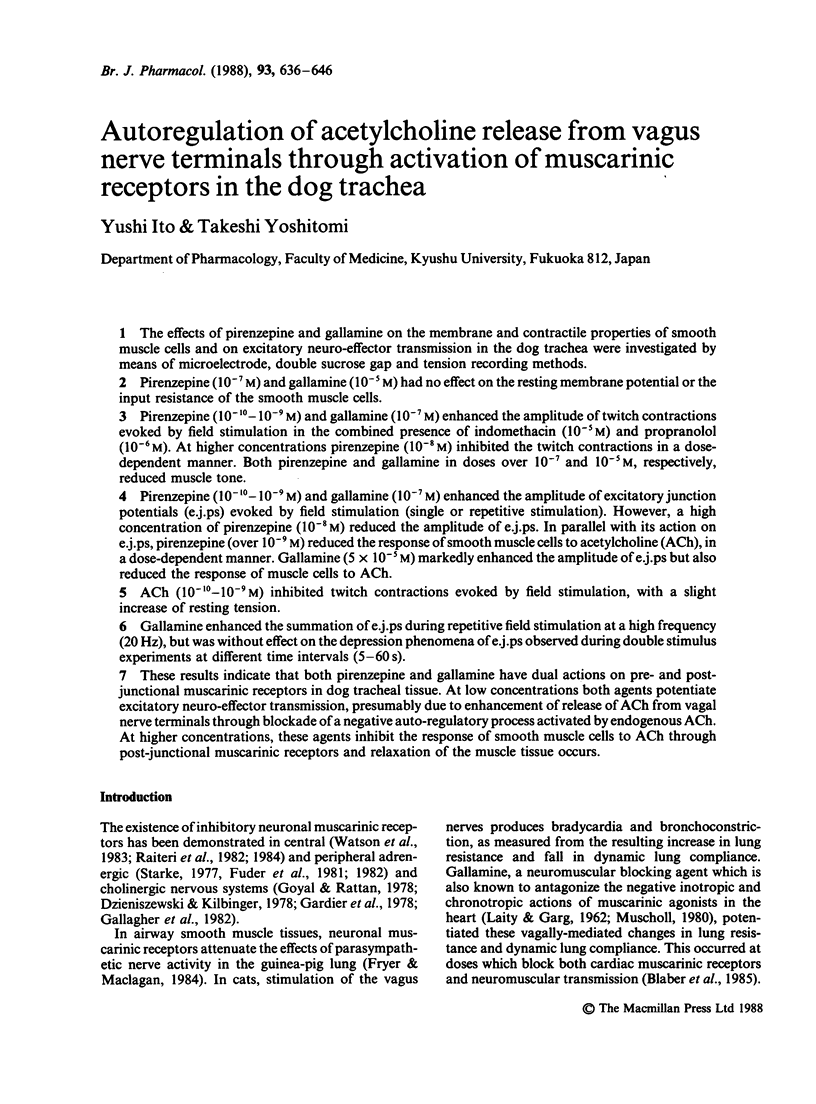

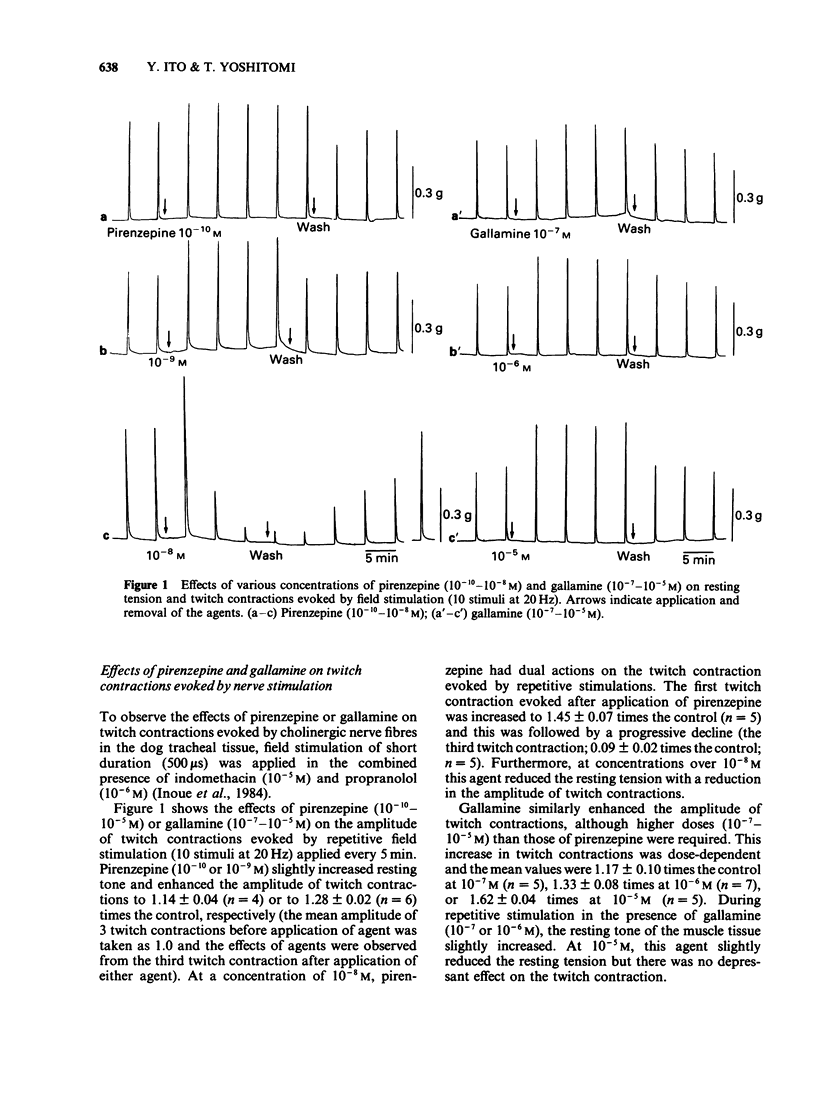
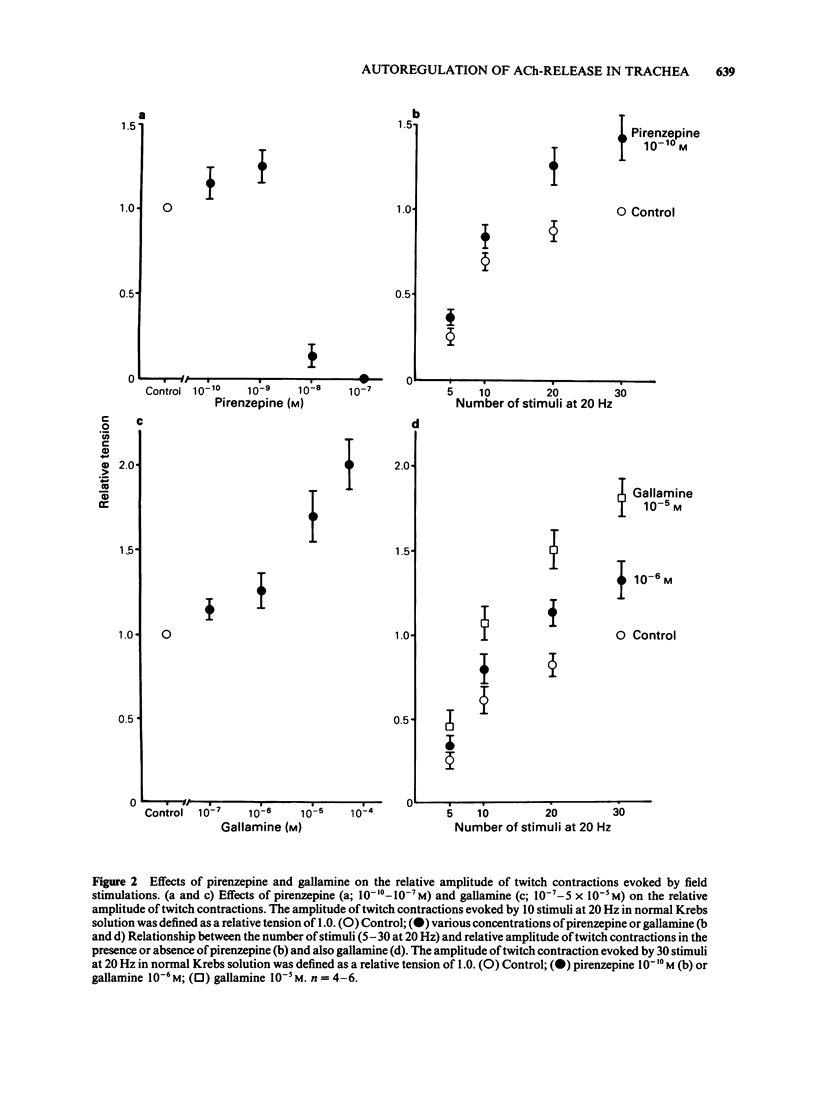
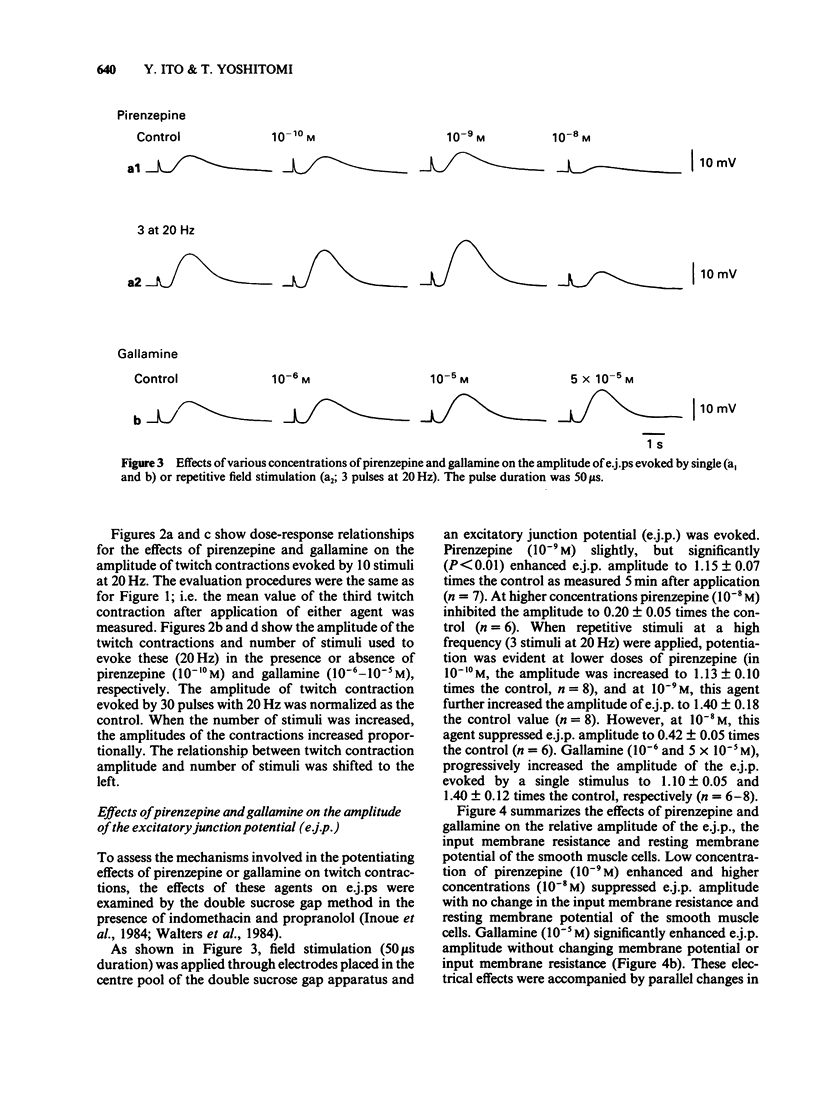
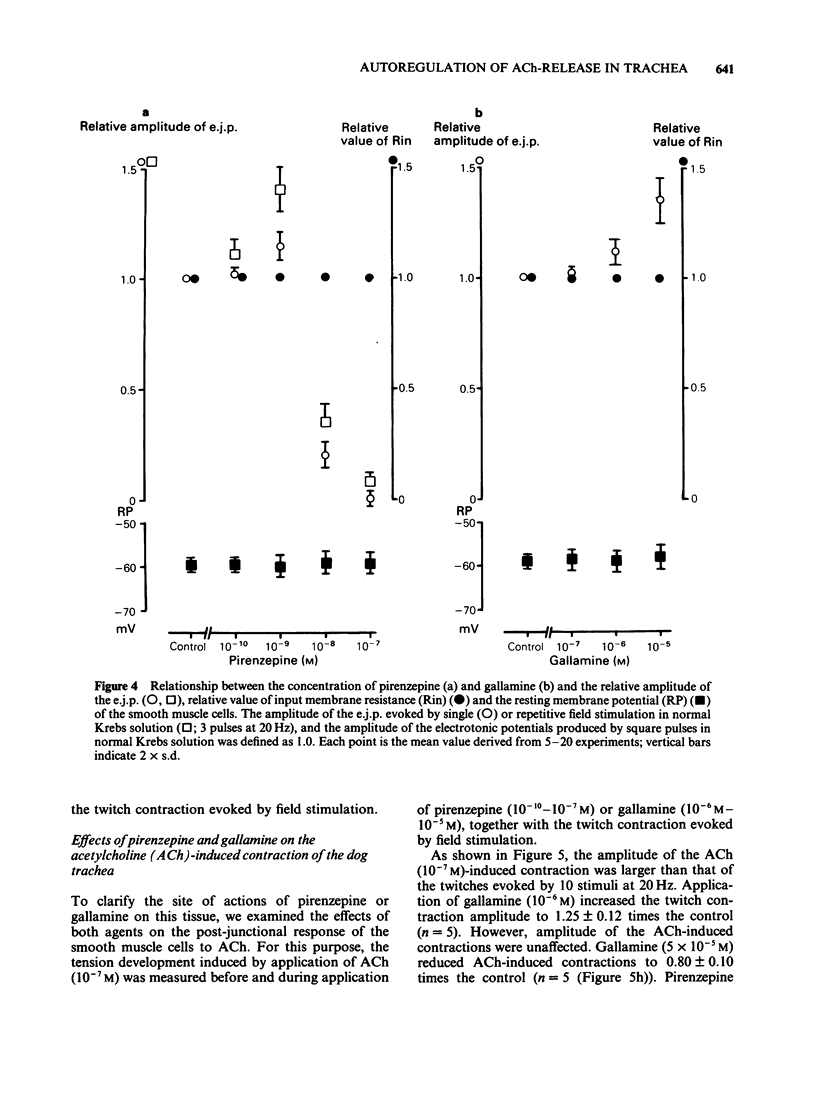
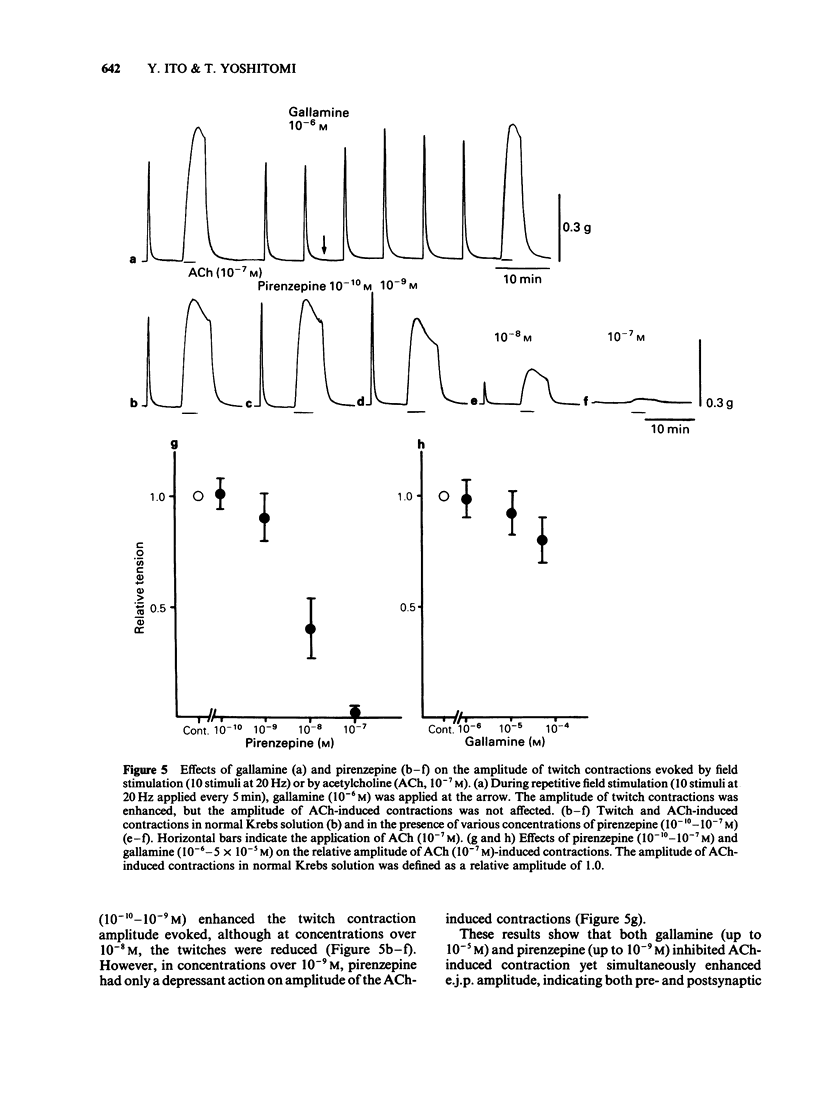
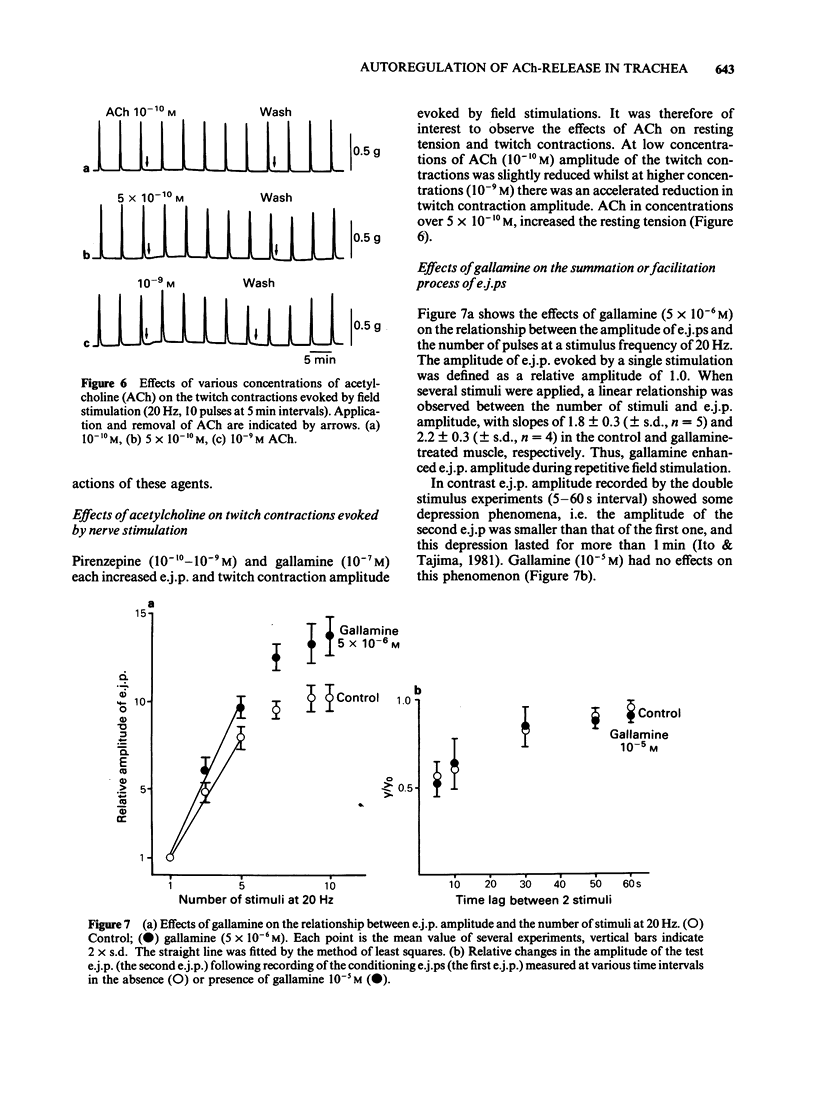

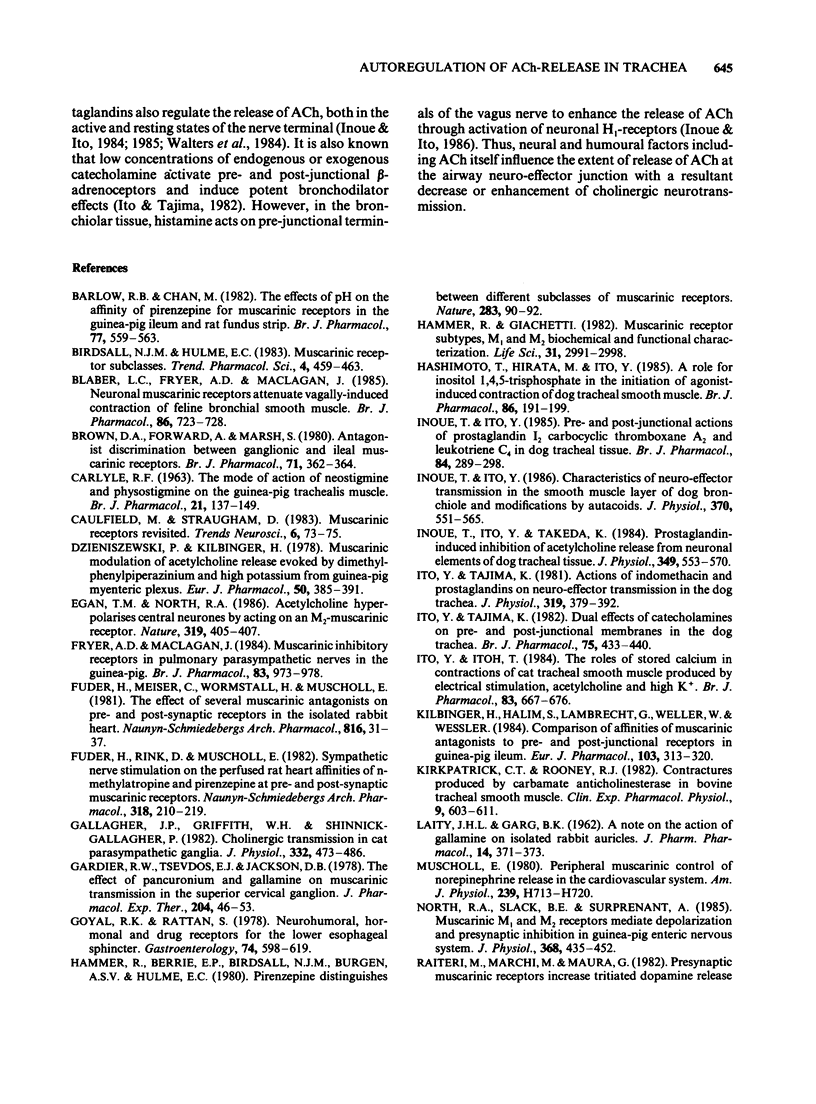

Selected References
These references are in PubMed. This may not be the complete list of references from this article.
- Barlow R. B., Chan M. The effects of pH on the affinity of pirenzepine for muscarinic receptors in the guinea-pig ileum and rat fundus strip. Br J Pharmacol. 1982 Nov;77(3):559–563. doi: 10.1111/j.1476-5381.1982.tb09331.x. [DOI] [PMC free article] [PubMed] [Google Scholar]
- Blaber L. C., Fryer A. D., Maclagan J. Neuronal muscarinic receptors attenuate vagally-induced contraction of feline bronchial smooth muscle. Br J Pharmacol. 1985 Nov;86(3):723–728. doi: 10.1111/j.1476-5381.1985.tb08951.x. [DOI] [PMC free article] [PubMed] [Google Scholar]
- Brown D. A., Forward A., Marsh S. Antagonist discrimination between ganglionic and ileal muscarinic receptors. Br J Pharmacol. 1980;71(2):362–364. doi: 10.1111/j.1476-5381.1980.tb10948.x. [DOI] [PMC free article] [PubMed] [Google Scholar]
- CARLYLE R. F. THE MODE OF ACTION OF NEOSTIGMINE AND PHYSOSTIGMINE ON THE GUINEA-PIG TRACHEALIS MUSCLE. Br J Pharmacol Chemother. 1963 Aug;21:137–149. doi: 10.1111/j.1476-5381.1963.tb01509.x. [DOI] [PMC free article] [PubMed] [Google Scholar]
- Dzieniszewski P., Kilbinger H. Muscarinic modulation of acetylcholine release evoked by dimethylphenylpiperazinium and high potassium from guinea-pig myenteric plexus. Eur J Pharmacol. 1978 Aug 15;50(4):385–391. doi: 10.1016/0014-2999(78)90144-9. [DOI] [PubMed] [Google Scholar]
- Egan T. M., North R. A. Acetylcholine hyperpolarizes central neurones by acting on an M2 muscarinic receptor. 1986 Jan 30-Feb 5Nature. 319(6052):405–407. doi: 10.1038/319405a0. [DOI] [PubMed] [Google Scholar]
- Fryer A. D., Maclagan J. Muscarinic inhibitory receptors in pulmonary parasympathetic nerves in the guinea-pig. Br J Pharmacol. 1984 Dec;83(4):973–978. doi: 10.1111/j.1476-5381.1984.tb16539.x. [DOI] [PMC free article] [PubMed] [Google Scholar]
- Fuder H., Meiser C., Wormstall H., Muscholl E. The effects of several muscarinic antagonists on pre- and postsynaptic receptors in the isolated rabbit heart. Naunyn Schmiedebergs Arch Pharmacol. 1981 Feb;316(1):31–37. doi: 10.1007/BF00507223. [DOI] [PubMed] [Google Scholar]
- Fuder H., Rink D., Muscholl E. Sympathetic Nerve Stimulation on the perfused rat heart. Affinities of N-methylatropine and pirenzepine at pre- and postsynaptic muscarine receptors. Naunyn Schmiedebergs Arch Pharmacol. 1982 Feb;318(3):210–219. doi: 10.1007/BF00500482. [DOI] [PubMed] [Google Scholar]
- Gallagher J. P., Griffith W. H., Shinnick-Gallagher P. Cholinergic transmission in cat parasympathetic ganglia. J Physiol. 1982 Nov;332:473–486. doi: 10.1113/jphysiol.1982.sp014425. [DOI] [PMC free article] [PubMed] [Google Scholar]
- Gardier R. W., Tsevdos E. J., Jackson D. B. The effect of pancuronium and gallamine on muscarinic transmission in the superior cervical ganglion. J Pharmacol Exp Ther. 1978 Jan;204(1):46–53. [PubMed] [Google Scholar]
- Goyal R. K., Rattan S. Neurohumoral, hormonal, and drug receptors for the lower esophageal sphincter. Gastroenterology. 1978 Mar;74(3):598–619. [PubMed] [Google Scholar]
- Hammer R., Berrie C. P., Birdsall N. J., Burgen A. S., Hulme E. C. Pirenzepine distinguishes between different subclasses of muscarinic receptors. Nature. 1980 Jan 3;283(5742):90–92. doi: 10.1038/283090a0. [DOI] [PubMed] [Google Scholar]
- Hammer R., Giachetti A. Muscarinic receptor subtypes: M1 and M2 biochemical and functional characterization. Life Sci. 1982 Dec 27;31(26):2991–2998. doi: 10.1016/0024-3205(82)90066-2. [DOI] [PubMed] [Google Scholar]
- Hashimoto T., Hirata M., Ito Y. A role for inositol 1,4,5-trisphosphate in the initiation of agonist-induced contractions of dog tracheal smooth muscle. Br J Pharmacol. 1985 Sep;86(1):191–199. doi: 10.1111/j.1476-5381.1985.tb09449.x. [DOI] [PMC free article] [PubMed] [Google Scholar]
- Inoue T., Ito Y. Characteristics of neuro-effector transmission in the smooth muscle layer of dog bronchiole and modifications by autacoids. J Physiol. 1986 Jan;370:551–565. doi: 10.1113/jphysiol.1986.sp015950. [DOI] [PMC free article] [PubMed] [Google Scholar]
- Inoue T., Ito Y. Pre- and post-junctional actions of prostaglandin I2, carbocyclic thromboxane A2 and leukotriene C4 in dog tracheal tissue. Br J Pharmacol. 1985 Feb;84(2):289–298. doi: 10.1111/j.1476-5381.1985.tb12913.x. [DOI] [PMC free article] [PubMed] [Google Scholar]
- Inoue T., Ito Y., Takeda K. Prostaglandin-induced inhibition of acetylcholine release from neuronal elements of dog tracheal tissue. J Physiol. 1984 Apr;349:553–570. doi: 10.1113/jphysiol.1984.sp015173. [DOI] [PMC free article] [PubMed] [Google Scholar]
- Ito Y., Itoh T. The roles of stored calcium in contractions of cat tracheal smooth muscle produced by electrical stimulation, acetylcholine and high K+. Br J Pharmacol. 1984 Nov;83(3):667–676. doi: 10.1111/j.1476-5381.1984.tb16220.x. [DOI] [PMC free article] [PubMed] [Google Scholar]
- Ito Y., Tajima K. Actions of indomethacin and prostaglandins on neuro-effector transmission in the dog trachea. J Physiol. 1981;319:379–392. doi: 10.1113/jphysiol.1981.sp013915. [DOI] [PMC free article] [PubMed] [Google Scholar]
- Ito Y., Tajima K. Dual effects of catecholamines on pre- and post-junctional membranes in the dog trachea. Br J Pharmacol. 1982 Mar;75(3):433–440. doi: 10.1111/j.1476-5381.1982.tb09158.x. [DOI] [PMC free article] [PubMed] [Google Scholar]
- Kilbinger H., Halim S., Lambrecht G., Weiler W., Wessler I. Comparison of affinities of muscarinic antagonists to pre- and postjunctional receptors in the guinea-pig ileum. Eur J Pharmacol. 1984 Aug 17;103(3-4):313–320. doi: 10.1016/0014-2999(84)90492-8. [DOI] [PubMed] [Google Scholar]
- Kirkpatrick C. T., Rooney P. J. Contractures produced by carbamate anticholinesterases in bovine tracheal smooth muscle. Clin Exp Pharmacol Physiol. 1982 Nov-Dec;9(6):603–611. doi: 10.1111/j.1440-1681.1982.tb00831.x. [DOI] [PubMed] [Google Scholar]
- LAITY J. L., GARG B. K. A note on the action of gallamine on isolated rabbit auricles. J Pharm Pharmacol. 1962 Jun;14:371–373. doi: 10.1111/j.2042-7158.1962.tb11108.x. [DOI] [PubMed] [Google Scholar]
- Muscholl E. Peripheral muscarinic control of norepinephrine release in the cardiovascular system. Am J Physiol. 1980 Dec;239(6):H713–H720. doi: 10.1152/ajpheart.1980.239.6.H713. [DOI] [PubMed] [Google Scholar]
- North R. A., Slack B. E., Surprenant A. Muscarinic M1 and M2 receptors mediate depolarization and presynaptic inhibition in guinea-pig enteric nervous system. J Physiol. 1985 Nov;368:435–452. doi: 10.1113/jphysiol.1985.sp015867. [DOI] [PMC free article] [PubMed] [Google Scholar]
- Raiteri M., Leardi R., Marchi M. Heterogeneity of presynaptic muscarinic receptors regulating neurotransmitter release in the rat brain. J Pharmacol Exp Ther. 1984 Jan;228(1):209–214. [PubMed] [Google Scholar]
- Raiteri M., Marchi M., Maura G. Presynaptic muscarinic receptors increase striatal dopamine release evoked by "quashi-physiological" depolarization. Eur J Pharmacol. 1982 Sep 10;83(1-2):127–129. doi: 10.1016/0014-2999(82)90296-5. [DOI] [PubMed] [Google Scholar]
- Starke K. Regulation of noradrenaline release by presynaptic receptor systems. Rev Physiol Biochem Pharmacol. 1977;77:1–124. doi: 10.1007/BFb0050157. [DOI] [PubMed] [Google Scholar]
- Tokimasa T. Spontaneous muscarinic suppression of the Ca-activated K-current in bullfrog sympathetic neurons. Brain Res. 1985 Sep 30;344(1):134–141. doi: 10.1016/0006-8993(85)91197-7. [DOI] [PubMed] [Google Scholar]
- Turbanti L., Subissi A., Bramanti G. Antimuscarinic drugs: traditional and potential new therapeutic agents. Pharmacol Res Commun. 1982 Nov;14(10):923–940. doi: 10.1016/s0031-6989(82)80057-x. [DOI] [PubMed] [Google Scholar]
- Walters E. H., O'Byrne P. M., Fabbri L. M., Graf P. D., Holtzman M. J., Nadel J. A. Control of neurotransmission by prostaglandins in canine trachealis smooth muscle. J Appl Physiol Respir Environ Exerc Physiol. 1984 Jul;57(1):129–134. doi: 10.1152/jappl.1984.57.1.129. [DOI] [PubMed] [Google Scholar]
- Watson M., Roeske W. R., Yamamura H. I. [3h]pirenzepine selectively identifies a high affinity population of muscarinic cholinergic receptors in the rat cerebral cortex. Life Sci. 1982 Nov 1;31(18):2019–2023. doi: 10.1016/0024-3205(82)90041-8. [DOI] [PubMed] [Google Scholar]


